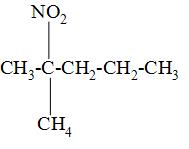
Answer
460.2k+ views
Hint: Nitroalkane contains the nitro group and the alkane and tertiary nitroalkane is that in which the carbon atom bonded to the nitro group contains the three-alkyl group. Now identify it.
Complete step by step answer:
Alkanes are the simplest hydrocarbon in which the carbon atoms are connected to each other through the C-C single bond and there is no double in between them, thus, also called as the saturated hydrocarbon. Their general chemical formula is ${{C}_{n}}{{H}_{2n}}$, here n is the number of the carbon atoms present in the molecule. Examples are methane (consisting of one carbon atom), ethane( consisting of two carbon atoms) ,propane (consisting of three carbon atoms) and so on.
When a nitro group is attached to the alkanes, then the alkanes are known as the nitroalkanes.
Depending on the number on the alkyl group (R-C) , attached to the carbon, the nitroalkanes can be classified into the following three categories:
1. Primary nitroalkanes: In this, one alkyl group is attached to the carbon atom bonded to the -OH group.
2. Secondary nitroalkanes: In this, two alkyl groups are attached to the carbon atom bonded to the -OH group.
3. Tertiary nitroalkanes: In this, three alkyl groups are attached to the carbon atom bonded to the -OH group.
So, to know which of the following from the above is the tertiary nitroalkane we will first have to write their structures.
So, from the above drawn structures of all nitroalkanes given, we can see that 2-methyl-2-nitropropane is the tertiary nitroalkane as its carbon atom is bonded to the three alkyl groups.
Hence, option(d) is correct.
Note: The aliphatic nitroalkanes are generally colorless while the aromatic nitroalkanes are mostly colored and they are soluble in the water and have ,thus, high boiling points due to the strong interactions of it with the water.
Complete step by step answer:
Alkanes are the simplest hydrocarbon in which the carbon atoms are connected to each other through the C-C single bond and there is no double in between them, thus, also called as the saturated hydrocarbon. Their general chemical formula is ${{C}_{n}}{{H}_{2n}}$, here n is the number of the carbon atoms present in the molecule. Examples are methane (consisting of one carbon atom), ethane( consisting of two carbon atoms) ,propane (consisting of three carbon atoms) and so on.
When a nitro group is attached to the alkanes, then the alkanes are known as the nitroalkanes.
Depending on the number on the alkyl group (R-C) , attached to the carbon, the nitroalkanes can be classified into the following three categories:
1. Primary nitroalkanes: In this, one alkyl group is attached to the carbon atom bonded to the -OH group.
2. Secondary nitroalkanes: In this, two alkyl groups are attached to the carbon atom bonded to the -OH group.
3. Tertiary nitroalkanes: In this, three alkyl groups are attached to the carbon atom bonded to the -OH group.
So, to know which of the following from the above is the tertiary nitroalkane we will first have to write their structures.
| Sr. no | Nitroalkane | Structure |
| 1. | 2-methyl-1-nitropropane | 
|
| 2 | 2-nitrobutane | 
|
| 3. | 1-nitrobutane | 
|
| 4. | 2-methyl-2-nitropropane | 
|
So, from the above drawn structures of all nitroalkanes given, we can see that 2-methyl-2-nitropropane is the tertiary nitroalkane as its carbon atom is bonded to the three alkyl groups.
Hence, option(d) is correct.
Note: The aliphatic nitroalkanes are generally colorless while the aromatic nitroalkanes are mostly colored and they are soluble in the water and have ,thus, high boiling points due to the strong interactions of it with the water.
Recently Updated Pages
Fill in the blanks with suitable prepositions Break class 10 english CBSE

Fill in the blanks with suitable articles Tribune is class 10 english CBSE

Rearrange the following words and phrases to form a class 10 english CBSE

Select the opposite of the given word Permit aGive class 10 english CBSE

Fill in the blank with the most appropriate option class 10 english CBSE

Some places have oneline notices Which option is a class 10 english CBSE

Trending doubts
Fill the blanks with the suitable prepositions 1 The class 9 english CBSE

How do you graph the function fx 4x class 9 maths CBSE

When was Karauli Praja Mandal established 11934 21936 class 10 social science CBSE

Which are the Top 10 Largest Countries of the World?

What is the definite integral of zero a constant b class 12 maths CBSE

Why is steel more elastic than rubber class 11 physics CBSE

Distinguish between the following Ferrous and nonferrous class 9 social science CBSE

The Equation xxx + 2 is Satisfied when x is Equal to Class 10 Maths

Differentiate between homogeneous and heterogeneous class 12 chemistry CBSE




